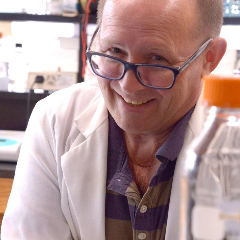Edward B. Dubrovsky

Professor
Department of Biological Sciences
Fordham University
Larkin Hall - 245
441 E. Fordham Road
Bronx, NY 10458
Office: 718-817-3660
Lab: 718-817-3663
Email: [email protected]
-
BS, Novosibirsk State University, Russia, 1980, Biology
PhD, Institute of Cytology and Genetics, Novosibirsk, Russia, 1988, Genetics
Postdoctoral fellow, Institute of Genetics and Molecular and Cellular Biology, Strasbourg, France, 1991-1995
Research Associate, Research Assistant Professor, Department of Biology, Dartmouth College, Hanover, NH, 1996-2005 -
Timing of cell proliferation, differentiation and apoptosis is critical for coordinated development of multi-cellular organisms. Metazoans establish developmental timing by utilizing the hormonal regulatory network. Hormones trigger cascades of gene activity in target tissues throughout the organism. With the aim to understand the way in which higher eukaryotes organize stage- and tissue-specific responses to hormonal signals, we work on the hormonal control of Drosophila development. Two hormones coordinately orchestrate the stereotyped program of insect growth and development. Ecdysone is responsible for initiating each developmental transition and Juvenile Hormone (JH) is critical for determining the nature of the transition.
JH is the most versatile insect hormone; it coordinates multiple developmental and physiological processes ranging from molting to aging. Although discovered over 70 years ago, the mechanism of JH action remains unknown. Moreover, despite long-standing efforts and interest, the search for a JH receptor has not been successful. The overall goal of research in the lab is to uncover the molecular mechanism underlying JH action. There are two different projects currently underway in our lab – both of them use the fruitfly Drosophila melanogaster and insect cultured cells, and both involve the combination of molecular genetics and cell biology approaches.
Previously, we identified a group of genes whose expression is induced by JH in Drosophila cultured cells. One of those genes – E75A – encodes the nuclear hormone receptor. E75A is the first known transcription factor that is induced directly by JH. Importantly, we found that JH regulation of E75 gene expression is conserved in mosquito, Anopheles gambiae, and moth, Manduca sexta, suggesting that the function of the E75 gene in JH signaling may be conserved as well. Our first project is on the hormonal control of E75 gene expression. We are working to identify cis-acting regulatory element(s) that confer JH-dependent transcriptional activation of E75. The Drosophila E75A promoter is a direct JH target: (i) it can be activated in the absence of protein synthesis; (ii) it is extremely sensitive to low levels of JH; and (iii) its activation is rapid and shows a decent fold of induction. The additional strength of this project is the use of comparative genomics, approved by our observation that E75 JH-responsiveness is conserved in evolutionary distant species of Diptera and Lepidoptera.
Our second project addresses the biological function of another JH-inducible gene, which is a Drosophila homolog of human ELAC2. ELAC2 is the prostate cancer susceptibility gene. We have found that: (i) Drosophila ELAC2 is an essential gene; (ii) the ELAC2 protein is a part of the tRNA maturation pathway; (iii) ELAC2 has an additional role besides tRNA processing, perhaps involving the cell cycle regulation. Presently, we are using genetic, biochemical, and molecular techniques to understand the role of ELAC2 during development of complex organisms.
-
Rajamani, S., Vilchez, L., Cracovia, N., Dule, D., Vata, A., Landaverde, S., Iyengar, A., and Dubrovsky, E.B. (2025). Mitochondrial-specific perturbation of Drosophila RNase Z in neurons leads to motor impairments, disrupted learning and neurodegeneration. PLoS Genet. 21(11): e1011938; doi:10.1371/journal.pgen.1011938.
Ouyang, X., Matt, A., Wang, F., Gracheva, E., Migunova, E., Rajamani, S., Dubrovsky, E.B., and Zhou, C. (2024). Attention LSTM U-Net model for Drosophila melanogaster heart tube segmentation in optical coherence microscopy images. Biomed. Opt. Express 15(6): 3639-3653; doi:10.1364/BOE.523364.
Migunova, E., Rajamani, S., Bonanni, S., Wang, F., Zhou, C., and Dubrovsky, E.B. (2023). Cardiac RNase Z edited via CRISPR-Cas9 drives heart hypertrophy in Drosophila. PLoS One 18(5): e0286214; doi:10.1371/journal.pone.0286214.
Migunova, E., Theophilopoulos, J., Mercadante, M., Men, J., Zhou, C., and Dubrovsky, E.B. (2021). ELAC2/RNaseZ-linked cardiac hypertrophy in Drosophila melanogaster. Dis. Model Mech. 14(8): dmm048931; doi:10.1242/dmm.048931.
Xie, X., and Dubrovsky, E.B. (2015). Knockout of Drosophila RNase ZL impairs mitochondrial transcript processing, respiration and cell cycle progression. Nucleic Acids Res. 43, 10364-10375; doi:10.1093/nar/gkv1149
Dubrovsky E.B., and Bernardo, T.J. (2014). The juvenile hormone receptor and molecular mechanisms of juvenile hormone action. Adv. Insect Physiol. 46, 305-388; doi:10.1016/B978-0-12-417010-0.00004-5
Bernardo, T.J., Dubrovskaya, V.A., Xie, X., and Dubrovsky E.B. (2014). A view through a chromatin loop: insights into the ecdysone activation of early genes in Drosophila. Nucleic Acids Res. 42, 10409-10424; doi:10.1093/nar/gku754
Xie, X., Dubrovskaya, V., Yacoub, N., Walska, J., Gleason, T., Reid, K., and Dubrovsky, E.B. (2013). Developmental roles of Drosophila tRNA processing endonuclease RNase ZL as revealed with a conditional rescue system. Dev. Biol. 381, 324-340; doi:10.1016/j.ydbio.2013.07.005
Bernardo, T.J., and Dubrovsky E.B. (2012). The Drosophila juvenile hormone receptor candidates Methoprene-tolerant (MET) and Germ cell-expressed (GCE) utilize a conserved LIxxL motif to bind the FTZ-F1 nuclear receptor. J. Biol. Chem. 287, 7821-7833; doi:10.1074/jbc.M111.327254
Bernardo, T.J., and Dubrovsky E.B. (2012). Molecular mechanisms of transcription activation by juvenile hormone: A critical role for bHLH-PAS and nuclear receptor proteins. Insects 3, 324-338; doi:10.3390/insects3010324
Xie, X., Dubrovskaya, V.A., and Dubrovsky, E.B. (2011). RNAi knockdown of dRNaseZ, the Drosophila homolog of ELAC2, impairs growth of mitotic and endoreplicating tissues. Insect Biochem. Mol. Biol. 41, 167-177; doi:10.1016/j.ibmb.2010.12.001
Dubrovsky, E.B., Dubrovskaya, V.A., Bernardo, T., Otte, V., DiFilippo, R., and Bryan, H. (2011). The Drosophila FTZ-F1 nuclear receptor mediates juvenile hormone activation of E75A gene expression through an intracellular pathway. J. Biol. Chem. 286, 33689-33700; doi:10.1074/jbc.M111.273458
Bernardo, T.J., Dubrovskaya, V.A., Jannat, H., Maughan, B., and Dubrovsky E.B. (2009). Hormonal regulation of the E75 gene in Drosophila: identifying functional regulatory elements through computational and biological analysis. J. Mol. Biol. 387, 794-808; doi:10.1016/j.jmb.2009.02.013
Dubrovsky, E.B. (2005). Hormonal cross talk in insect development. Trends Endocrinol. Metab. 16, 6-11; doi:10.1016/j.tem.2004.11.003